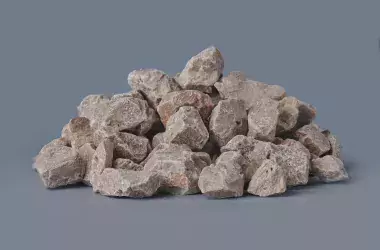Dolomite

What is Dolomite?
Dolomite, also known as dolomitic limestone, magnesian limestone, or dolostone, is a mineral composed of calcium magnesium carbonate (CaCO3.MgCO3). It forms through the process of dolomitization, where calcium carbonate undergoes partial or full transformation.
Dolomite is quarried, crushed, and ground into various fractions for diverse applications. It is widely used in agriculture to improve soil quality, in refractories due to its magnesium content, and in the paint and plastics industries as a filler material.
Properties of dolomite:
- Appearance: White, pink, green, gray, brown, or black
- Chemical Formula: CaCO3.MgCO3
- Melting Point: Since dolomite is transformed into oxides before melting can occur no value can be given
- Density: Typically around 2.75 - 2.90 g/cm³ (Boynton)
Applications of dolomite:
Dolomite has a wide range of applications across various industries due to its unique properties:
- Construction: Utilized as an aggregate in construction, in the production of concrete, and as a dimension stone.
- Agriculture: Enhances soil quality by neutralizing acidity and supplying vital nutrients such as magnesium and calcium.
- Refractories: Because of its high melting point and magnesium content, dolomite is utilized in manufacturing refractory bricks.
- Chemical Industry: A source of magnesium oxide (MgO), which is used in numerous chemical processes.
- Paint and Plastics: Acts as a filler in the paint and plastics industries, improving the properties of the end products.
- Metallurgy: Employed as a flux in blast furnaces to eliminate impurities from metal ores.
- Water treatment: Used in water treatment to adjust pH levels and remove impurities.
Lhoist’s brands for dolomite are: Dolofrit®, Doloram®, Calexor®, and more.
Frequently Asked Questions (FAQs)
What is the primary difference between dolomite and limestone?
While both dolomite and limestone are containing calcium carbonate, dolomite also contains magnesium carbonate (CaCO3·MgCO3). This additional magnesium content distinguishes dolomite from limestone and gives it unique properties suitable for various applications.
How does dolomite improve soil quality in agriculture?
Dolomite neutralizes soil acidity and supplies essential nutrients such as magnesium and calcium, which are essential for plant growth. It enhances the overall fertility and structures the soil, for example for agriculture.
Why is dolomite preferred over other materials in the production of refractory bricks?
Dolomite’s resistance to heat and chemical attack makes it ideal for manufacturing refractory bricks used in high-temperature environments like furnaces.
What role does dolomite play in the chemical industry?
In the chemical industry, dolomite serves as a source of magnesium oxide (MgO), which is used in various processes such as the production of fertilizers, magnesium salts, and as a catalyst in chemical reactions.
How does dolomite function as a filler in paints and plastics?
Dolomite improves the properties of paints and plastics by increasing durability, providing a smoother finish, and enhancing the product’s resistance to wear and tear. Its fine particle size and chemical stability make it a preferred filler material.